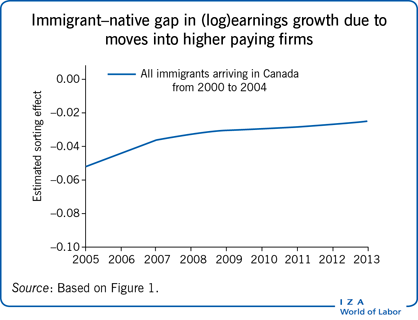Elevator pitch
Recent research has tried to quantify how firms contribute to the immigrant–native earnings gap. Findings from several countries show that around 20% of the gap is due to firm policies that lead to a systematic underrepresentation of immigrants at higher-paying firms. Results also show that some of the closing of the gap over time is attributable to the reallocation of immigrants toward higher-paying employers. This pattern is especially pronounced for immigrants coming from disadvantaged countries, who face several barriers at initial entry, including language difficulties and lack of recognition of their educational credentials.

Key findings
Pros
The immigrant–native earnings gap is due in part to firm-specific factors.
Most firm-specific factors stem from immigrants sorting into low-pay firms rather than high-pay firms.
Immigrants with higher levels of education can assimilate more quickly through mobility from low- to high-pay employers.
Immigrants who remain in the host country longer have greater success finding jobs with high-pay employers.
Cons
Some immigrants are stuck in low-pay firms, particularly those with low levels of education, poor literacy, and poor language skills.
Even with high education levels, unfavorable sorting is also due to poorly recognized education credentials.
Poor recognition of education credentials of immigrants could be due to lower educational quality or unequal treatment of similarly productive workers.
There is a lack of research on the role of firms explaining the native–immigrants earnings gap due to the non-availability of suitable data.